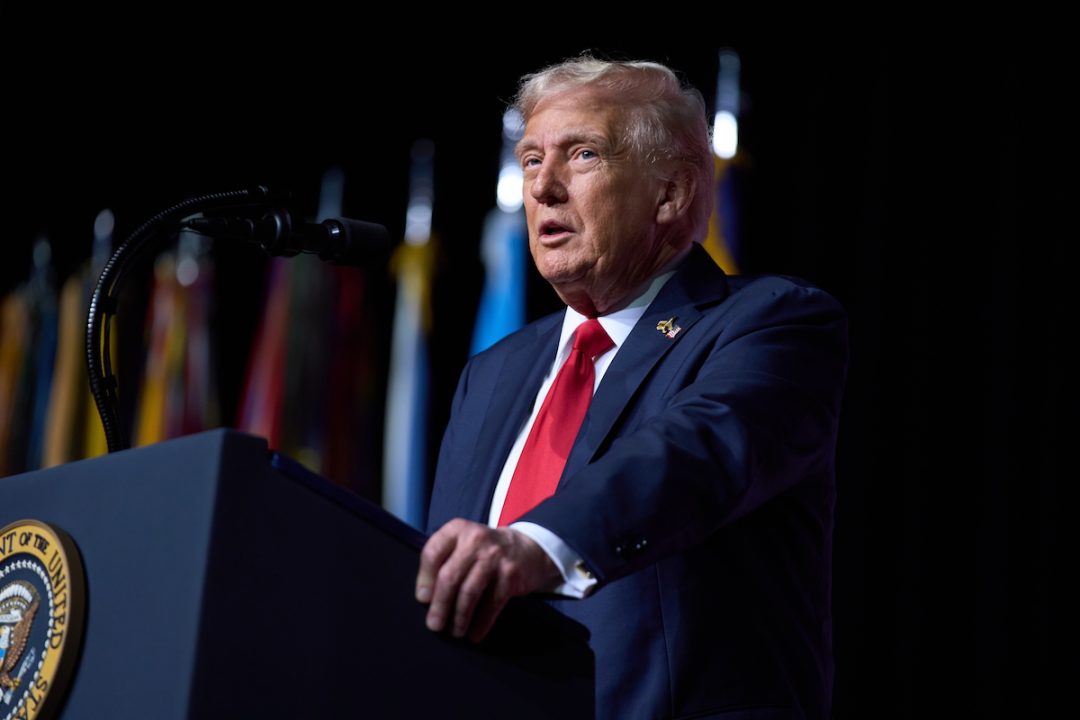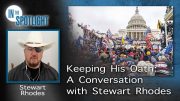
On Tuesday, President Trump addressed the Joint Chiefs of Staff, his war secretary, and senior commanders (transcript is available here) at Marine Corps Base Quantico in Virginia. The session was convened to review military readiness, budget priorities, and upcoming initiatives. The agenda included new weapons programs, expanded force structure, and the administration’s shift in doctrine under the restored name “Department of War.” It was both a policy briefing and a directive, outlining the missions Trump expects the armed forces to undertake in the coming year.
However, the most striking element of the address was not the budget figures or hardware announcements, but the language Trump used to describe the nation’s internal situation. He warned that America is under assault, not from abroad but from within:
We’re under invasion from within, no different than a foreign enemy, but more difficult in many ways…
The military, he stressed, should defend not only the nation’s borders but its streets, treating domestic disturbances as a theater of war.
D.C. as a Case Study
Trump held up Washington, D.C., as a proof of concept for his vision of military intervention in American cities. On August 11, he signed Executive Order 14333 placing the Metropolitan Police Department (MPD) under federal control. The order also mobilized the D.C. National Guard under federal command and called in Guard units from other states to “augment the mission.” Trump justified the takeover by citing a “crime emergency,” even though both independent and official data (see here and here) showed violent crime in the capital was already at or near a 30-year low.
Before the generals, he framed the operation as an overwhelming success:
Washington D.C. was the most unsafe, most dangerous city in the United States of America…. And now … after 12 days of serious, serious intensity, we took out 1,700 career criminals…. I drove through it two days ago, it was beautiful…. Washington D.C. is now a safe city.
But the claim carries its own contradiction. If Washington is now “just about our safest” city, why keep federalized police and a militarized Guard on the streets? Trump presents the crackdown as both a finished success and an ongoing necessity. By his telling, 1,700 criminals are gone, yet the emergency remains, for now extended through December. The capital becomes not only proof of “restored order” but a standing rationale to export the model elsewhere.
Democrat “War Zones”
From the D.C. example, Trump shifted to a broader urban frame. He lambasted Democratic governance:
The Democrats run most of the cities that are in bad shape…. But it seems that the ones that are run by the radical left Democrats, what they’ve done to San Francisco, Chicago, New York, Los Angeles, they’re very unsafe places and we’re going to straighten them out one by one.
He made his militarized vision explicit:
And this is going to be a major part for some of the people in this room. That’s a war too. It’s a war from within.
From there, the speech unraveled into repetition and improvisation. Trump blended warnings of urban crime with an immigration narrative:
We had millions coming in, pouring in. 25 million all told.… Many of them should never be in our country. They would take their worst people.… They put them in a caravan and they’d walk up.
Then came the startling proposal:
I told [Secretary of War] Pete [Hegseth], we should use some of these dangerous cities as training grounds for our military National Guard, but military, because we’re going into Chicago very soon.
Chicago
Chicago was Trump’s prime example. He ridiculed the state’s leadership in crude terms:
That’s a big city, with an incompetent governor, stupid governor.… Last week they had 11 people murdered, 44 people shot.… Every weekend they lose five, six. If they lose five, they’re considering it a great week. They shouldn’t lose any.
The language was designed to paint a picture of a city in total collapse, a battlefield crying out for federal troops. But the facts tell a more complicated story. Through the first half of 2025, shootings and homicides in Chicago were each down more than 30 percent compared with the year before. City officials celebrated the summer as the safest since 1965.
None of that means Chicago is without tragedy. The city still sees brutal weekends: over Labor Day, 58 people were shot, eight fatally. In July, a mass shooting at an album-release party left four dead and 14 wounded. Neighborhood violence, concentrated in a handful of areas, remains stubborn and devastating.
But that is not the same as a city “out of control.” Yet Trump is proposing to deploy the military into a city where violent crime is, by all indications, manageable — because he says a governor is “stupid.” To treat one of America’s largest cities as a “war zone,” useful above all for demonstrating who, in his words, is “the boss.”
Portland
Trump then took aim at Portland:
Portland, Oregon, where it looks like a war zone…. Unless they’re playing false tapes, this looked like World War II. Your place is burning down.… This place is a nightmare.
Trump tied it directly to opposition to immigration enforcement:
They go after our ICE people, who are great patriots.
The protests were concentrated outside the ICE facility on Macadam Avenue, beginning in early June. Demonstrators staged sit-ins and marches, accusing the agency of abusive detention practices and calling for the facility’s closure. On June 12, police arrested 10 protesters. At the same time, federal officers were reported to fire pepper balls and other munitions from the building’s roof at the protesters blocking the driveway. The city logged multiple instances of chemical munitions being used in nearby neighborhoods, raising public health, safety, and constitutional concerns.
Legally, the line is clear: Disrupting or obstructing the work of federal law enforcement is a federal offense. Some protesters in Portland were arrested on precisely those grounds. But much of the activity remained lawful dissent under the First Amendment.
Trump erased that distinction. A protest movement — messy, controversial, and at times crossing into illegality — became, in his telling, a battlefield worthy of military occupation.
“They Spit, We Hit”
Trump turned crowd control into combat doctrine. He described protesters spitting in soldiers’ faces and announced a new rule: “They spit, we hit.”
He then described rocks and bricks smashing federal vehicles, and declared:
You get out of that car and you can do whatever the hell you want to do.
Of course, spitting at an officer is contemptible and sometimes criminal, but it is not a license to “hit.” Likewise, vague commands like “do whatever the hell you want” in situations perceived as life-threatening invite excess, civil liability, and political abuse. The danger is not only what civilians might do in the street, but what soldiers may come to believe they are free to do in return.
Elastic Math
It should be briefly noted how casually Trump bends numbers to justify military involvement in domestic life, especially on immigration. On the campaign trail, his team warned seniors of “10 million illegals” supposedly made eligible for Social Security. That number came from border encounters, a measure that includes repeat crossings and expulsions.
Even allies such as Representative Chip Roy (R-Texas) used smaller numbers. His 2024 report cited 8.5 million crossings, with 5.6 million released and two million “gotaways.”
Back in office, Trump now claims “25 million all told.” The figure grows with every retelling.
There is no question that illegal immigration imposes costs, from local budgets to drugs and trafficking. But Trump’s distortion is not about precision. It is crafted to turn a legitimate problem into a pretext for treating U.S. cities as military battlefields.
A New Domestic Unit
Trump reminded his audience that the machinery is already in motion:
Last month, I signed an executive order to provide training for a quick reaction force that can help quell civil disturbances.
The order directs the secretary of war to carve out a new policing arm inside the D.C. National Guard, “dedicated to ensuring public safety and order in the Nation’s capital,” “other cities” and even “nationwide.” Members can be deputized by the attorney general, the secretary of the interior, or the secretary of homeland security to enforce federal law — a blending of roles that erases the line between soldiers and police.
Trump cited past presidents who used troops for domestic order. By invoking the oath against “all enemies, foreign and domestic,” he made clear that “domestic” is now part of the military mission.
Training Grounds
Commentators often wave off Trump’s rhetoric as bluster. But when the commander-in-chief tells generals that American cities should serve as “training grounds,” it cannot be dismissed.
In military practice, training grounds are controlled spaces with safety rules and legal oversight. Trump reframed them as real cities, treating communities as battlegrounds rather than places where millions live.
That shift is not symbolic. Spoken by the nation’s top military authority, it reads less as metaphor than as directive. The gap between rhetoric and policy is perilously thin when the speaker can issue orders. What Trump framed as readiness is, in effect, a call to militarize civic life.
Law and Constitution
The legal ground for Trump’s approach is shaky. The Posse Comitatus Act bars federal troops from civilian policing. The Insurrection Act permits exceptions, but only under specific emergencies such as insurrection or the collapse of state authority. Using cities as “training grounds” would stretch the statute beyond recognition.
The National Guard is the hinge. Under state authority, Guard members can enforce law. Once federalized, they cannot. A federally controlled “quick reaction force” to police protests blurs that boundary and invites abuse.
The gravity of Trump’s moves are hard to overestimate. They risk transforming the military from a shield against foreign attack into an instrument of domestic control, eroding the very limits meant to preserve a free republic — and setting a precedent that future presidents could exploit.




